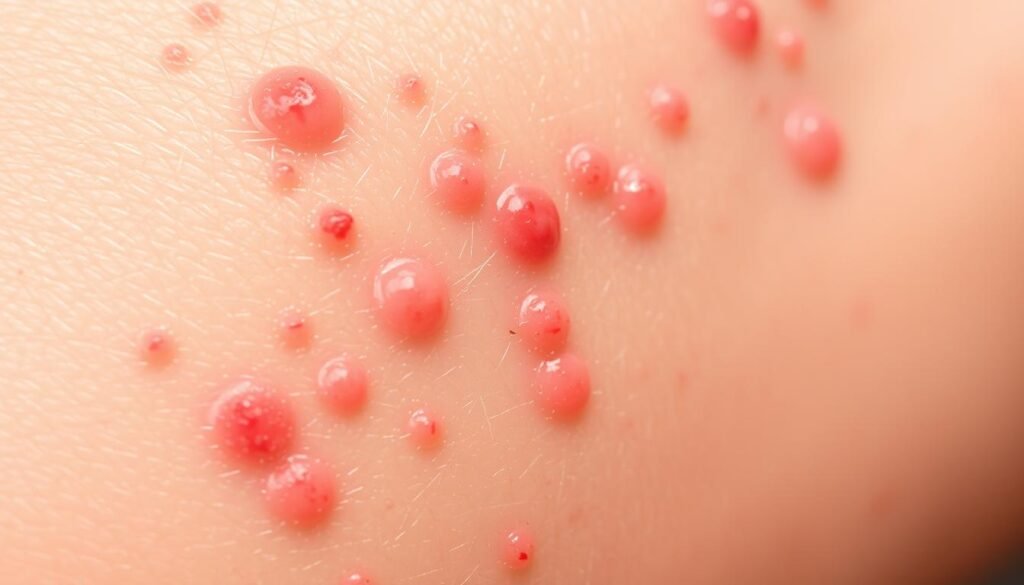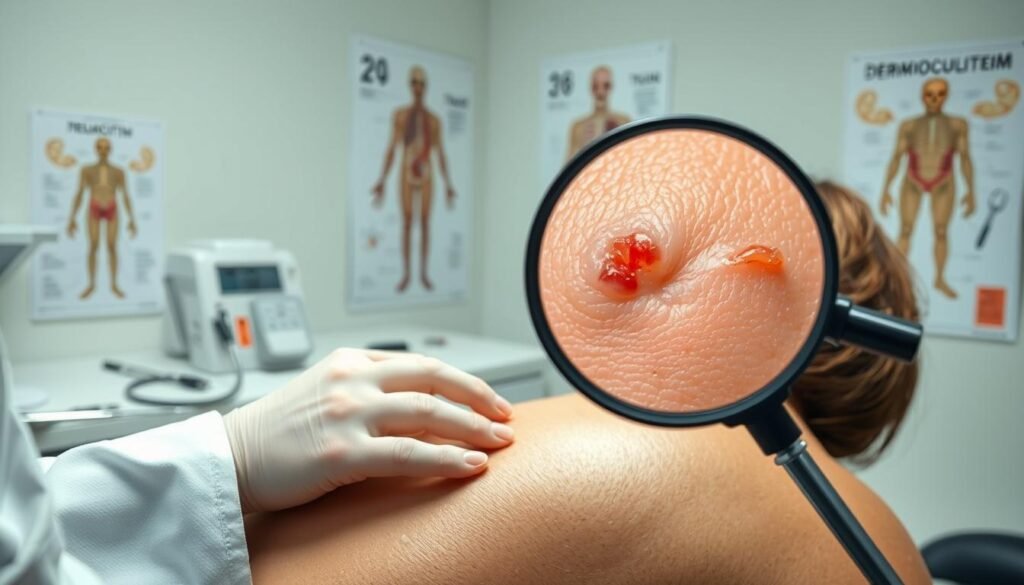About 1 in 4 people will deal with skin problems linked to hair follicles at some point. Folliculitis is an inflammation of these follicles. It’s commonly seen and needs the right diagnosis for effective treatment. In this article, we’ll look at how doctors figure out if someone has folliculitis.
Doctors start by looking at your medical history and examining you. They also use lab tests to find what’s causing the issue. To learn more about diagnosing folliculitis, check out these detailed resources.
Key Takeaways
- Folliculitis is a widespread condition affecting hair follicles.
- Getting the right diagnosis is key to treating and managing it effectively.
- Checking your medical history and a physical exam are crucial first steps.
- Lab tests, like skin scrapings, pinpoint the cause.
- Bacterial culture is a vital diagnostic tool for folliculitis.
Understanding Folliculitis
Folliculitis is a skin issue where hair follicles get inflamed. It can come from bacteria or fungi. Knowing the causes of folliculitis helps treat and prevent it.
Things that can cause folliculitis include:
- Excessive sweating
- Shaving or plucking hair
- Use of certain medications
- Poor hygiene practices
Folliculitis can show up on your scalp, face, or legs. Knowing these factors is key. Dealing with the causes of folliculitis early can reduce discomfort. It also helps keep your skin healthy.
Signs and Symptoms of Folliculitis
Folliculitis is easy to spot if you know what to look for. People often find small red bumps near their hair. These can turn into blisters filled with pus. Along with these bumps, you might feel itching or soreness, clear signs of swelling.
How bad folliculitis gets can vary from one person to another. For some, it’s just a slight annoyance. Others might feel a lot of pain and have it spread over larger areas. Spotting folliculitis early is crucial. Otherwise, it could get worse.

| Signs of Folliculitis | Symptoms of Folliculitis |
|---|---|
| Small red bumps | Itching |
| Pus-filled blisters | Tenderness around the area |
| Inflammation | Possible pain |
| Crusting over the bumps | Discomfort when touched |
Knowing these symptoms is key. It lets people get help early. This can lead to a better chance of quick recovery and stop things from getting worse.
How Folliculitis is Diagnosed
To diagnose folliculitis, doctors start by reviewing your medical history. They then check your skin closely, looking for signs of this condition. This helps them know what type of folliculitis you have and decide how to treat it.
Doctors might ask about your skin care routine or life habits that might have caused the issue. They want to know about your shaving practices, the clothes you wear, and if you’ve been around any irritants. This information helps them understand your condition better.
It’s key to figure out what’s causing your folliculitis to manage it well. Mayo Clinic has more info. Knowing if bacteria or fungus is involved can help your doctor pick the best treatment.

Some people might need more tests to confirm folliculitis. Doctors may take skin samples or do lab tests to find the exact cause. Knowing about these tests can make patients more involved in their treatment decisions.
Getting the right diagnosis is very important. It’s the first step to treating folliculitis well. If you have symptoms, see a doctor early for the best care.
Importance of a Comprehensive Medical History Review
Reviewing your complete medical history is key to correctly identifying folliculitis. Dermatologists will ask about your past skin issues, your current medicines, your lifestyle, and if you’ve come into contact with anything irritating. This talk is crucial. It reveals root causes and other factors.
Knowing your medical past can make diagnosing much more precise. Doctors can spot patterns that might be missed without this info. They look into your previous skin problems, your current health conditions, what medicines and supplements you’re taking, allergies you have, and what you’re exposed to at work or at home.
This detailed approach is vital for figuring out the right treatment. By understanding what’s unique about each patient, dermatologists can come up with plans that work better. This means they can really help heal your skin.

| Factor | Relevance in Diagnosis |
|---|---|
| Past Skin Conditions | May indicate susceptibility to recurrent folliculitis. |
| Existing Health Issues | Can complicate treatment options and responses. |
| Current Medications | Some drugs may trigger or exacerbate folliculitis. |
| Allergies and Sensitivities | Important for determining potential irritants. |
| Environmental Exposures | Helps identify external factors affecting skin health. |
Physical Evaluation: What to Expect
When you go for a physical evaluation for folliculitis, a dermatologist will examine your skin closely. They’ll look for inflammation and swelling, shown by small red bumps or pus-filled ones. Recognizing the distribution and type of these bumps helps diagnose you correctly.
This evaluation might also include checking areas like lymph nodes. It helps figure out if the condition has affected your system more widely. With this detailed check-up, dermatologists can suggest specific treatments. These may involve creams or advice on caring for your skin at home.
If you have symptoms of folliculitis, it’s important to share your full medical history with the doctor. Mention any recent skin issues, irritants, or habits that might make your skin worse. For tips on dealing with folliculitis, take a look at this helpful guide.
Skin Examination Techniques Used by Dermatologists
Dermatologists use many skin examination techniques to diagnose folliculitis accurately. Dermatoscopy is a key technique. It improves how well they can see hair follicles and lesions. This makes their evaluations more precise. Seeing the skin clearly is vital for identifying its unique features.
Feeling the skin, or palpation, is also important. It helps doctors tell the difference between folliculitis and other skin problems by feeling the skin’s texture and any raised areas. This step is crucial for a correct diagnosis.
There are different types of folliculitis, each with its own signs. Dermatologists know how to spot these signs thanks to their training. They look for certain conditions, like eosinophilic pustular folliculitis which can be related to HIV or problems from treatments. For more details, they often turn to resources like medical tests and examinations.
| Technique | Description | Purpose |
|---|---|---|
| Dermatoscopy | A non-invasive tool that magnifies and illuminates the skin. | Enhances visibility of lesions and follicles. |
| Palpation | Manual examination of skin texture and lesion elevation. | Assesses the characteristics of the skin and lesions. |
| Visual Assessment | Systematic observation of skin appearance and changes. | Helps identify the presence of folliculitis and its variants. |
Laboratory Tests for Folliculitis
Laboratory tests are key in diagnosing folliculitis. Doctors may order tests such as bacterial cultures and skin scrapings to find the cause. These tests help identify the bacteria or fungi causing the problem.
Bacterial cultures help find the specific bacteria or fungi. Skin scrapings let doctors see if there’s a fungal infection or another cause. This information helps choose the right treatment.
It’s important to know how too much biotin affects test results. It can mess up the accuracy of some Diagnostic Tests. Always talk to a healthcare professional before taking supplements. This helps avoid negative effects and keeps your hormonal balance in check. Check out more on this topic at biotinlife.com.
Using these tests, doctors can provide the best care for folliculitis. It helps them make informed decisions on treatment.
Bacterial Culture: An Essential Diagnostic Tool
A bacterial culture is vital for diagnosing folliculitis, which shows up as pus-filled blisters. This method involves taking a sample from the skin. Health professionals can then figure out the exact bacteria causing the problem. Knowing the type of bacteria helps doctors pick the right treatment.
Finding the specific bacteria causing folliculitis is key. It helps doctors understand the problem better. They can then prescribe the right antibiotics. This means patients are more likely to get better quickly, with less severe symptoms.
In short, a bacterial culture is crucial for treating folliculitis correctly. It allows for an accurate diagnosis and effective treatment. By identifying the bacteria accurately, doctors can choose the best treatment. This leads to faster healing and happier patients.
